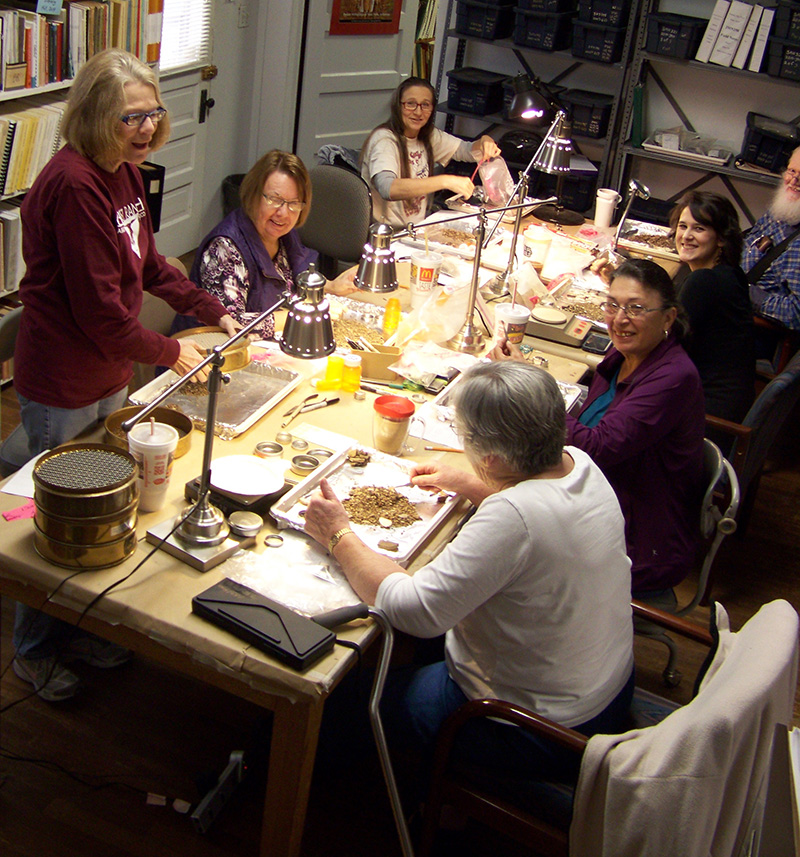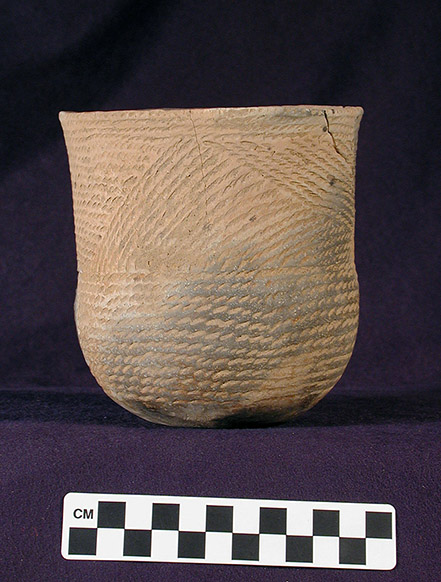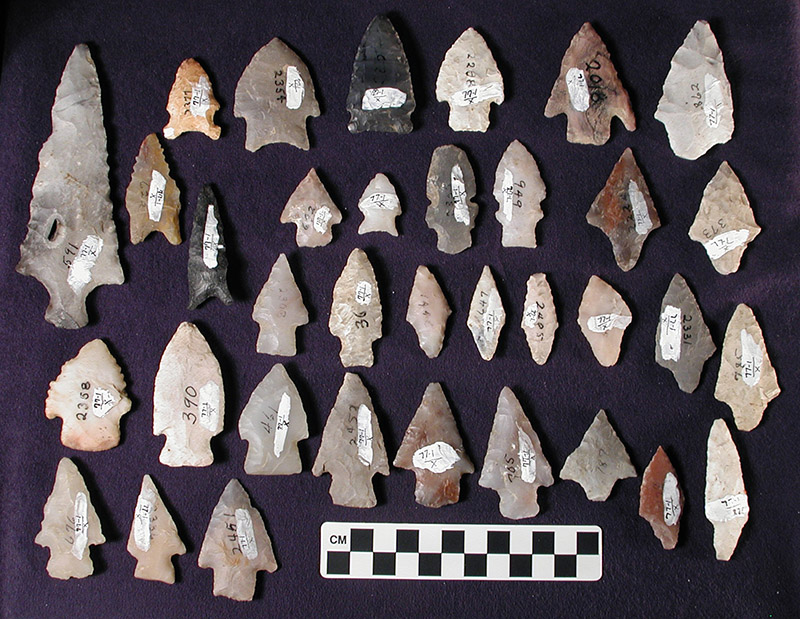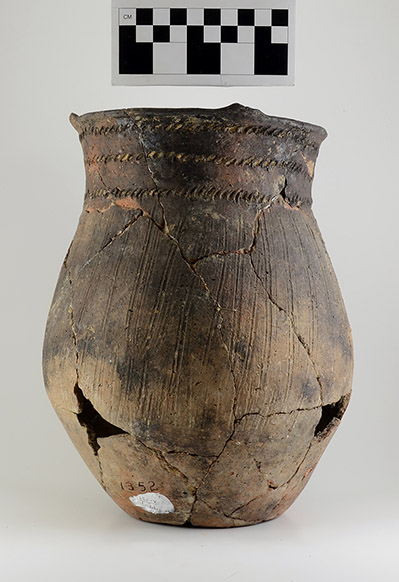
Mary Beth Trubitt (Arkansas Archeological Survey, HSU Research Station)
Henderson State University and Ouachita Baptist University’s Joint Educational Consortium owns a large collection of Native American artifacts that is curated by the Survey’s HSU Research Station in Arkadelphia. Survey professional staff, assisted by Arkansas Archeological Society and HSU student volunteers, are documenting Caddo pottery in this significant historical collection. A 2006 grant from the Ross Foundation funded an earlier phase of this long-term research project.
This collection was amassed in the 1930s and 1940s by Thomas and Charlotte Hodges, Bismarck residents who were interested in the local history and archeology of Clark and Hot Spring counties. This interest was shared by Arkadelphia residents Robert Proctor, Vere Huddleston, Richard Reid, and Charlie Richardson. In addition to visiting archeological sites and collecting artifacts, these early avocational archeologists left a legacy. They were among the founders of the Arkansas Historical Association and early version of the Arkansas Archeological Society. The Hodgeses were active participants in early Caddo Conferences, and they and Huddleston wrote several articles for publication. Proctor donated his collection to the HSU Museum. The Hodgeses bought the Menard mound site in 1941 to preserve it (the Menard-Hodges site is now part of the National Park Service’s Osotouy Unit of the Arkansas Post National Memorial). And they provided assistance to the few professional archeologists who visited this part of Arkansas. Both Philip Phillips and Alex D. Krieger, who went on to become leading figures in Mississippi River Valley and Caddo area archeology respectively, photographed vessels from the Hodges and Huddleston collections in the 1930s. Some of these became the “type vessels” for Caddo ceramic types still used today. Phillips was shown archeological sites by the Hodgeses during his 1939 Ouachita River Valley survey, and Charles R. McGimsey III visited Charlotte Hodges to learn about local sites during his 1963 survey of the DeGray Reservoir area.

After the Joint Educational Consortium acquired the Hodges collection in 1977, Ann Early and her staff at the Survey’s HSU Research Station accessioned, catalogued, and photographed artifacts. Early was able to identify site locations for some objects using the limited records. There are about 50,000 pieces in the collection, mostly stone tools and broken potsherds but also about 1350 whole, reconstructed, and partial ceramic vessels. This includes a collection purchased from Richard Reid, and another purchased from the widow of Vere Huddleston. Huddleston left more complete notes than those of his contemporaries, and his records provide context for a subset of the artifacts in the collection.
Our detailed documentation of the Caddo pottery in the JEC Hodges Collection includes digital photography and description, measurement, and analysis of temper and paste, vessel size and form, surface treatment and decoration. This long-term research project has several goals. First, we have developed exhibits to interpret Caddo Indian history and lifeways in the Middle Ouachita River Valley using these artifacts. There have been four small exhibits in Arkadelphia (in HSU’s Huie Library, in OBU’s Riley-Hickingbotham Library, in the Ross Foundation headquarters, and in the Clark County Historical Association Museum). In 2019, a permanent space was created in HSU’s Caddo Center for exhibiting artifacts in the JEC Hodges Collection and interpreting Caddo Indian history in the local area. HSU student Emily Miller wrote a pamphlet on effigy pottery in the JEC Hodges Collection. Publications serve to broadcast project results more widely.



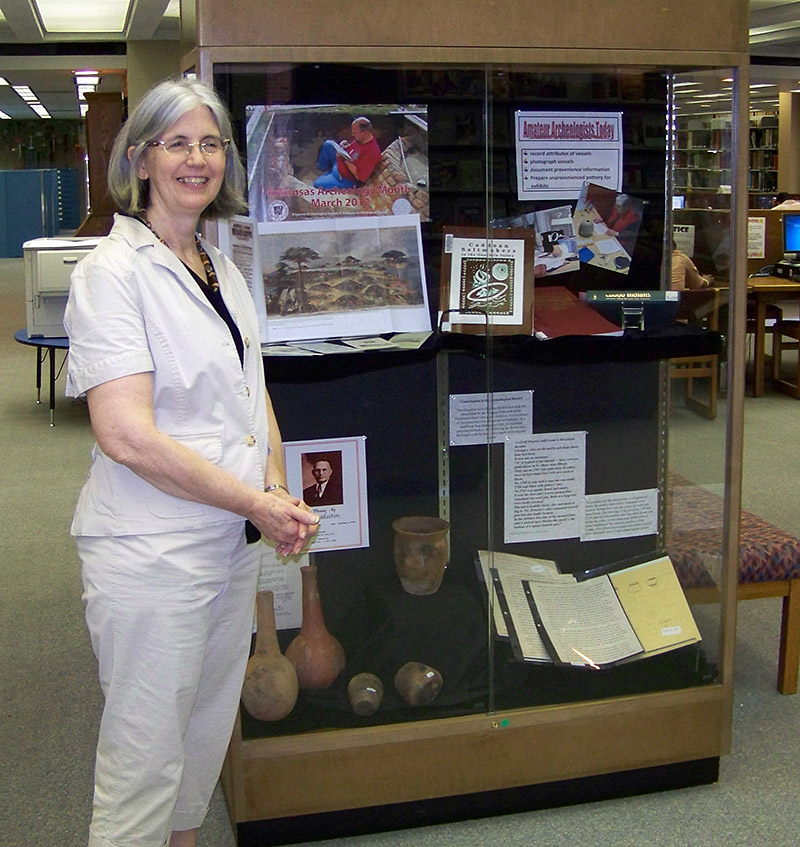

Second, we learn about the history and archeology of this region by studying the artifacts in this collection that can be tied to specific known archeological sites. Since they were visited by Thomas and Charlotte Hodges and Vere Huddleston over 75 years ago, many of the Caddo mounds along the Ouachita River have been washed away by flooding, plowed for farming, and bulldozed for construction. The sparse records from the 1930s and 1940s – and our modern analyses of the artifacts from these archeological sites – provide important information on this history. Comparisons of ceramic vessels can show whether nearby sites were occupied at the same time or whether people shifted community location over time. We can see long-term trends in technological details such as the material used to temper the clay. There may be signs of use, as pots may have soot from fires on the outside or have food residues on the inside. Caddo Indian potters burnished and decorated the surfaces of bowls and bottles with engraved lines, while exteriors of cooking jars were typically incised, punctated, or brushed. The “descriptive system” or “collegiate system” developed by Frank Schambach and Ann Early differentiates decorative patterns and designs on Caddo pottery. We are learning how pottery designs changed through time and across space, and investigating how form and design signaled group identity and social boundaries in southwest Arkansas. Archeologists are exploring the iconography and meanings of abstract designs found on pottery and comparing them with representational designs seen on other materials in the Caddo area and across the Southeast.

The JEC Hodges Collection includes some artifacts that were dug from graves in the 1930s and 1940s. The Caddo included pottery in graves of the dead as containers for food for the journey of the person’s soul into the next world, so many modern Caddo Indians look at these pots as more than art objects or items for study. Nowadays we consult with descendant groups about sacred objects and grave goods (as well as about any disturbances to ancient cemeteries), guided by federal legislation such as the 1990 Native American Graves Protection and Repatriation Act and by state legislation such as the 1991 Arkansas Act 753. A third goal of this project is to advise representatives of the JEC and the Caddo Nation as they consult about this collection. Our documentation provides information about which pots and other artifacts can be linked together with human remains from specific graves.
The JEC Hodges Collection is a significant historical collection of Native American artifacts. Most of the objects can be tied to a specific area of west-central Arkansas and linked to ancestral Caddo Indian sites in the Middle Ouachita River Valley. A small number of artifacts were collected by Thomas and Charlotte Hodges from Menard and other ancestral Quapaw Indian sites in Arkansas County. This collection is important for learning more about the history and archeology of Arkansas Indians, it is important to the people who live in Arkadelphia and surrounding communities, and it is important to modern-day Caddo and Quapaw Indians.
